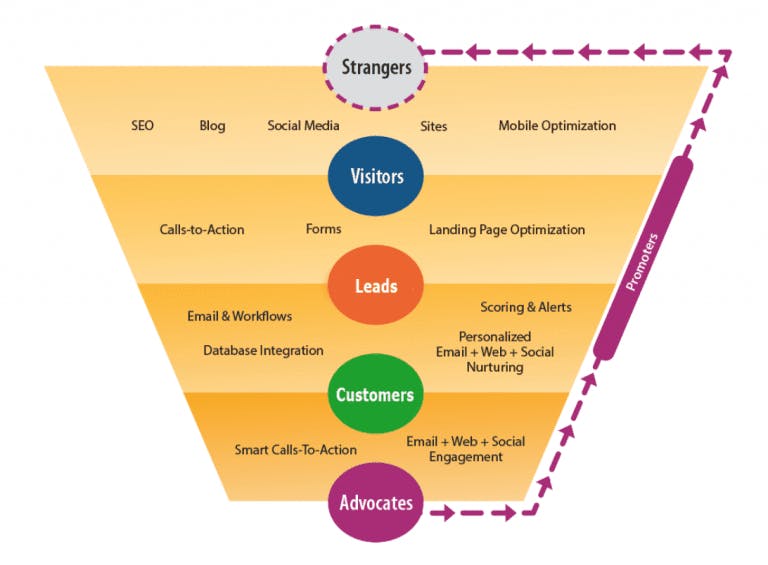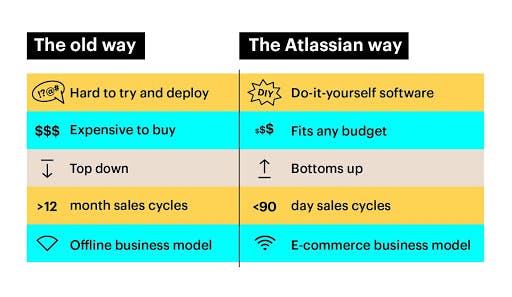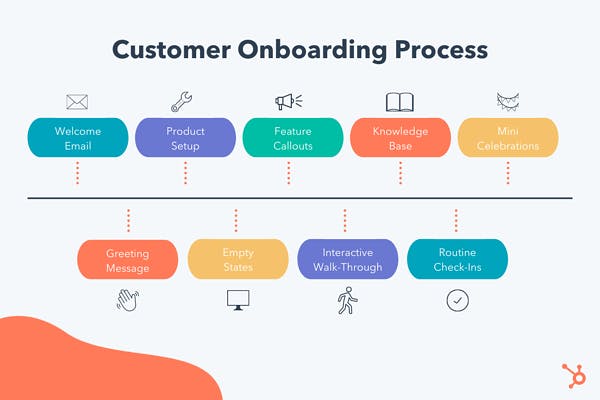What is SaaS marketing? Strategies, planning and metrics
Apr 12th, 2021

Contents
What is SaaS marketing?
SaaS marketing strategy and its components
How to create and implement SaaS marketing plan
SaaS marketing metrics
Conclusion
Software as a service or SaaS is a way of application distribution that allows accessing the software via an Internet browser instead of downloading and installing it. In the SaaS model, the applications run on the SaaS provider’s servers. The products range from business software to personal entertainment applications and advanced IT tools. The SaaS model’s primary advantages over traditional software are accessibility, lower upfront costs, compatibility, ease of use, and operational management.
Slack is one of the fastest-growing SaaS startups in history. From March 2020 to April 2021, Slack generated $902 million in revenue, a 43 percent increase over the previous year. The application has over 12 million daily users and more than 156,000 subscribed organizations.
The critical ingredients for success are simplicity of use, reliability, and openness to integrations. However, the role of outstanding marketing in the company’s success cannot be denied. Right after the launch, Slack used personal recommendations to encourage users to try the app for free, leave feedback and invite friends. Later, the startup sponsored ten podcasts with loyal audiences, such as “99% Invisible”, “Startup”, and created two own podcasts like “The Slack Variety Pack”. The chosen marketing strategy was extremely successful, and now Slack is one of the most valuable SaaS brands on the planet.
Due to the reason that SaaS is a digital product, when developing a marketing strategy, you need to focus solely (or at least primarily) on the digital channels. Therefore, SaaS marketing differs substantially from any other type of traditional marketing. Further, we will explain the difference in detail.
What is SaaS marketing?
SaaS marketing is a type of marketing that focuses on promoting and selling subscription-based applications. The main principle of the SaaS model is to sell cloud-based products with constant updates and added functionality. SaaS marketing strategies are usually based on providing free trials and rewards for referrals, optimizing the website for conversions, ensuring easy sign-up, running PPC campaigns, and requesting customers to leave reviews.
The sales cycle of SaaS products is usually very short. According to the SaaS marketing model, firstly, the potential customer finds the product online, visits the website, does some research, then tries the software, and finally subscribes to the website.

Source: appmarketingminds.com
The main challenge of the SaaS model is the intangible product. The customers cannot see the physical item, so they need to test the product before the purchase with the help of a free trial, demo, or free trial-to-paid membership. Many applications require a monthly subscription instead of a single payment, creating additional challenges for convincing potential customers to make a purchasing decision.
The other difference between SaaS marketing and the traditional marketing model is customer service. SaaS products always require periodic updates that influence product performance. Sometimes this results in customer dissatisfaction. That is why the vital aspect of SaaS marketing strategy is reliable customer service, social media support, helpdesk, and the resources provided on your website.
One more crucial aspect related to SaaS product marketing is customer retention. The SaaS model is based on a monthly or yearly subscription, so it is incredibly important to retain your customers. According to the study by Bain&Co, increasing customer retention by 5 percent may boost your profits by up to 95 percent.
Moreover, retention is of greater importance than acquisition in the Software as a Service model. Thus, you need to interest a potential customer, provide a test version of the product, keep the user informed and demonstrate the advantages of staying subscribed to your services. In addition, you need to dedicate your marketing budget to customer retention on top of customer acquisition.
Building awareness
Building awareness is the first step in your overall SaaS marketing strategy. You need to define the target audience and find the right channels to draw the attention of your potential customers and generate sales. There are several ways to increase your SaaS products’ visibility, such as blogging, email marketing, partnering with well-established companies, participation in conferences and other events, creating social media campaigns, asking customers for reviews, podcasting, and others.
However, describing the product is not enough. In the SaaS marketing model, you need not only demonstrate the benefits of the product but also show the potential customers how to use it. This can be done with the help of step-by-step guides, demos, or explainer videos.
SaaS funnel and the complex customer journey
The customer journey in the SaaS marketing model usually consists of five steps: awareness, evaluation, decision, retention, and advocacy. Unlike the traditional marketing model, where the final step of the sales funnel is the purchase, the perfect endpoint for the SaaS funnel is a customer referral. While moving along the sales funnel, the customer learns more information about the product and your business.

Source: prosper-strategies.com
At the first stage of the SaaS sales funnel, a potential customer is searching for the solution to his problem. So, you need to build awareness, identify customer’s pain points, and provide solutions to their needs at this stage. You can generate educational content in the form of blog posts, e-books, whitepapers, analyst reports, infographics, and others.
Once the customer has defined the problem, the client tries to understand what solution would be the most suitable. At the consideration stage, you can respond to customer’s concerns by providing free webinars, newsletters, expert guides, and resources on your website.
The next stage of the SaaS customer journey is the decision. The customer weighs the advantages and disadvantages of your product and compares your offering with your competitors’ products. To convince the potential buyer to make a final purchasing decision, you can provide the demos or trial downloads, product literature, consultations, testimonials, or case studies.
When the potential client makes the decision and turns into an active client of your business, you need to retain them by asking questions, conducting interviews, measuring satisfaction levels, and streamlining the resolution of their support tickets. You can continue educating the customers about your product by providing product updates, training courses, how-to guides, documentation, and support.
At the final stage of the SaaS sales funnel, your foremost goal is to turn the customer into your brand advocate. Word-of-mouth is a powerful tool in the SaaS marketing strategy, so you should encourage customers to make personal recommendations. You can nudge your clients to become more active brand advocates with referral programs, discounts, and promotions.
Marketing in SaaS
The sales process in SaaS marketing does not often require direct customer interaction and sales teams. One of the most popular sales models for SaaS businesses is the self-serve model. In this model, the customers manage the sales process by themselves. They find, purchase, and use the product having no assistance from the customer representatives’ side. The self-serve model’s primary advantage is low investments, so it is suitable for startups and micro-businesses that do not have a sales team.
The key role in the self-serve sales model lies with the marketing department. The marketing team is responsible for creating educational content, publishing posts, raising awareness, and helping users manage the sales process on their own.
Atlassian is a superb example of a company that successfully uses the self-serve model to generate more revenue from large corporate clients. The company, famous for the products like HipChat and Jira, does not have a sales team relying on the partner channel and the website. The unique sales model has enabled the company to earn $1.6 billion annual revenue in 2020.

Source: intercom.com
Long-term customer success
The ultimate goal of the SaaS marketing process is to keep customers satisfied and motivate them to extend the subscription to your services. Due to this, excellent customer support is the other critical component of the SaaS marketing model.
According to statistics, businesses lose more than $75 billion a year due to poor customer support. Therefore, you need to build an ongoing relationship with your customers. To retain the clients and reduce the churn rate, you should implement some practices, including asking for feedback, ensuring the product satisfies customer needs, providing upgrades to the product, and maintaining communication through different channels.
SaaS marketing strategy and its components
SaaS marketing strategy is not a simple recipe or ready-made solution. It is always a combination of several different activities and approaches.
Inbound content marketing
Inbound marketing focuses on finding the customer’s pain point and providing a solution. The customer searches for the way to tackle a particular problem, finds the necessary educational resources, and purchases the product or service which satisfies their requirements. Thus, inbound content marketing strategy is aimed at providing relevant content and increasing brand visibility.
Content marketing is the basis of the inbound marketing strategy. The quality content creates value for the potential customers and turns them into buyers. The content should be authentic, educational, engaging, and tailored for the specific audience. You can distribute the content in the form of blog posts, social media articles, infographics, podcasts, and videos.
Search engine optimization
SEO takes on the challenge of improving the visibility of your website for potential customers. Organic search is a large part of the website performance for many businesses and often a primary source of digital traffic. Search engine optimization helps increase your ranking in Google search results and, consequently, drive more traffic to your website.
Search engines like Google use a set of algorithms that define what pages to show for a particular search query. There is a massive number of factors that influence the search engine results pages. The most important ones are the links, page structure, and content. Some of the techniques to optimize the factors include keyword research, link building, content marketing, and on-page optimization. If you correctly optimize these components, your website will rank higher in search results.
Social media marketing and pay-per-click advertising
Social media marketing is a perfect way to reach your target audience. This strategy allows for increasing brand awareness, driving more inbound traffic, improving brand loyalty. The main trends of social media marketing for 2021 are story formats, influencer marketing, and video content production.
In the PPC advertising model, the businesses running ads pay each time the user clicks on the online advertisements. Pay-per-click ads come in different types, but the most common one is paid search advertisements. The users see these ads when they enter a search query in Google. At this moment, the search engine makes algorithmic calculations to define what ads to display. To make the most of this tactic, you need to bid on the keywords relevant to your business.
Similarly, you can create pay-per-click ads on social media platforms, such as Facebook or Instagram. The main difference between social media and search engine PPC is that in social media ads, you focus on showing them to a particular target audience, but you can not address searches for specific topics they might be interested in.
Focused online presence
It is crucial to find the best places online to present your brand, such as industry-specific media, social media groups and channels, online communities, and forums. By defining the appropriate digital marketing channels, you can create strong brand positioning, reach your target audience and communicate your brand message.
To build an excellent digital presence, you need to understand your goals, study the target audience and competitors, set the marketing budget, leverage the most effective social media channels, create a user-friendly website, offer high-quality content, and communicate with the customers.
Video marketing
Video marketing is a strategy based on video content and used to promote and market the product or service, educate the customers, and increase social media engagement. Video is the preferable kind of content for many users.
You can create various types of videos, including brand videos, explainer videos, educational how-to videos, demo videos, event videos, customer testimonial videos, and others. Considering video marketing trends in 2021, you should pay attention to live video streaming format, 360-degree video experiences, animated explainer videos, shoppable videos, and long storytelling.
Email marketing
Email marketing centers on promoting products and services, building awareness, and increasing customer loyalty. It is also a perfect way to educate the audience on the brand value and maintain communication with the customers. Email is one of the most cost-effective tools that allow for driving traffic to your blog, build a relationship with clients, and target customers by demographic by segmenting your email marketing lists.
You can add the newsletter signup to your website and direct users to the newsletters from social media pages. The newsletter helps send information about important updates, events, and discounts. The major advantage of emails over social media posts is a higher probability for the users to see the message. The customers are more likely to receive and open your email than get your social media post into their feeds.
Webinars
Webinars are another original form of activity to interest the audience in your product or service and then continue the communication involving the customers into your sales cycle. Hosting a webinar is also a direct engagement with the customers that helps generate leads and conversions.
One of the advantages of webinar marketing is interactivity and the opportunity to gain insights from the polls, surveys, and the audience reaction. With the help of in-depth analytics provided by webinars, you can understand how much the audience is interested in your product or service.
Partnerships and co-marketing with players in related industries
Partnerships with other companies are a prevalent practice in the SaaS marketing model. The two companies agree to cooperate in order to drive sales and increase revenue. There are many different types of partnerships, such as partnerships for referrals, technical partnerships, product integrations, co-sell and resell relationships, and others.
Co-marketing is usually a non-monetary type of partnership that requires the lowest level of involvement from both companies. This partnership type promotes a shared offer, such as a piece of content or co-branded product. The participants of co-marketing partnerships often have similar audiences. The companies agree to host the event or work on the piece of content and promote it to both audiences. As a result, the brands can receive twice the number of potential customers.
Free trial and onboarding
Free trial is a powerful technique that helps users evaluate the advantages of the software and make the buying decision. Free trials are not the obligatory element of each SaaS sales funnel. However, this technique creates a great potential to increase your sales. Your free trial should be valuable, easy to sign up for, and supported with onboarding by providing additional information about the functionality, and your service features and benefits.
Customer onboarding activities are related to welcoming new customers to a company. The onboarding focuses on improving the understanding and ease of use for the customer, thus building customer loyalty and brand advocacy. The onboarding methods usually include welcome emails, product registration, and customer service support.

Source: hubspot.com
Marketing to your existing customers
Marketing to existing customers is critical for SaaS businesses. Keeping the existing customers requires less time and lower expenses, encourages the buyers to make repeat purchases, and helps promote your product via personal recommendations.
To increase revenue from the existing customers, you need to research your market, maintain consistent communication, provide a personalized experience, create a loyalty program, update your offerings and search for upselling opportunities.
How to create and implement SaaS marketing plan
Step 1. Market research
SaaS market analysis will help you understand whether you target the right companies. It will also be useful in understanding the industry trends, industries that can benefit from your service, relevant market sizes, and the geography of your clients.
Firstly, you need to identify your potential customers, determine their pain points and the core value you can create for them. Then you should understand what differentiates your product from the other competitors on the market. The most valuable techniques in this matter would be SWOT analysis, competitive matrix, win/loss analysis, and customer surveys.
Step 2. Client profile development
Developing a client profile will provide you with a deeper understanding of customer needs, better market segmentation, increased efficiency of marketing campaigns, and better partnership with the sales team. The most suitable methods of creating a client profile include qualitative feedback using surveys, focus groups, in-depth interviews, and quantitative research using market segmentation tools, web analytics, and other internal or publicly available data.
Step 3. Marketing activities implementation
The next step is the implementation of your marketing activities. If you want your marketing efforts to be successful, you need to set the right expectations. The marketing team is one more essential point of your overall strategy. The unit can include members of your marketing or sales department or outsourced marketing consultants. You need to communicate the plan to your team and ensure that everyone is on the same page. To simplify the strategy implementation process, divide it into small tasks with deadlines and create a detailed project timeline.
Step 4. Customer acquisition
This is a complex step that includes many different activities and tasks. To acquire new customers, you should work on your online presence and reputation. The key to success is an informative, user-friendly, and attractive website with valuable content. The other components of successful customer acquisition are high-performance landing pages, optimized pricing pages, and feedback from previous customers.
Step 5. Measure and review success
To estimate the success of your SaaS marketing strategy, you should select the right metrics. The best approach is to analyze data from your company’s website, including the number of unique visitors, page views, conversion rate, search engine traffic, and bounce rate.
Step 6. Focus on the customer needs
The last step of the SaaS marketing plan is to cater to your existing customer base needs and attract new customers at the same time. It is essential to determine client expectations by collecting feedback and building a knowledge base to seek customer satisfaction levels. Use the feedback for growth and improvement to involve new customers.
SaaS marketing metrics
The key SaaS marketing metrics are unique visitors, lead velocity rate, monthly recurring revenue, churn, customer lifetime value, and customer acquisition cost.
Unique visitors
Unique visitors metric is the number of individual visits to your website during a specified period of time. If your SaaS startup has a significant number of unique visitors, it means that your content meets the needs of your target audience. The most suitable tool for measuring the number of unique visitors per day, per week, or per month is Google Analytics.
Conversion rate
Conversion rate is the percentage of user actions performed after visiting your website or landing page. The most common types of conversions include making a purchase, engaging with online chat, signing up for a subscription, etc.
Conversion Rate = Total number of conversions / Total number of sessions * 100
Lead velocity rate
Lead velocity rate enables measuring the increase of qualified leads in the current month compared to the past month. In simple terms, LVR is the percentage of potential clients you are turning into actual customers.
Customer acquisition cost
Customer acquisition cost is the sum of costs spent on new customer acquisition. CAC can include marketing and sales employees’ salary, advertising costs, etc.
Customer Acquisition Cost = Total Dollars Spent on Acquisition / Number of Customers Acquired.
Customer lifetime value
Customer lifetime value is the amount of time the customer will spend with your product or service during his interaction with the company. To calculate CLTV, you need to multiply customer value per month by average customer lifespan in months.
Churn rate
SaaS churn rate is the percentage at which the users terminate the subscriptions in some specific period of time.
Customer Churn Rate = (Lost Customers ÷ Acquired Customers) x 100%
Monthly recurring revenue
It is one of the most crucial metrics for subscription-based businesses. MRR is the amount of your predictable revenue per month. Monthly recurring revenue is calculated according to the following formula:
MRR = number of customers * average billed amount.
Conclusion
The secrets of SaaS startup success often lie in the choice of the right partners, excellent work of the customer success team, smooth onboarding experience, and tracking of the SaaS marketing metrics. However, proper planning is not a guarantee of success. The most important part of the SaaS marketing process is the strategy implementation. You can rely on your internal marketing department or engage a marketing consultant or an agency to manage your SaaS marketing issues.
